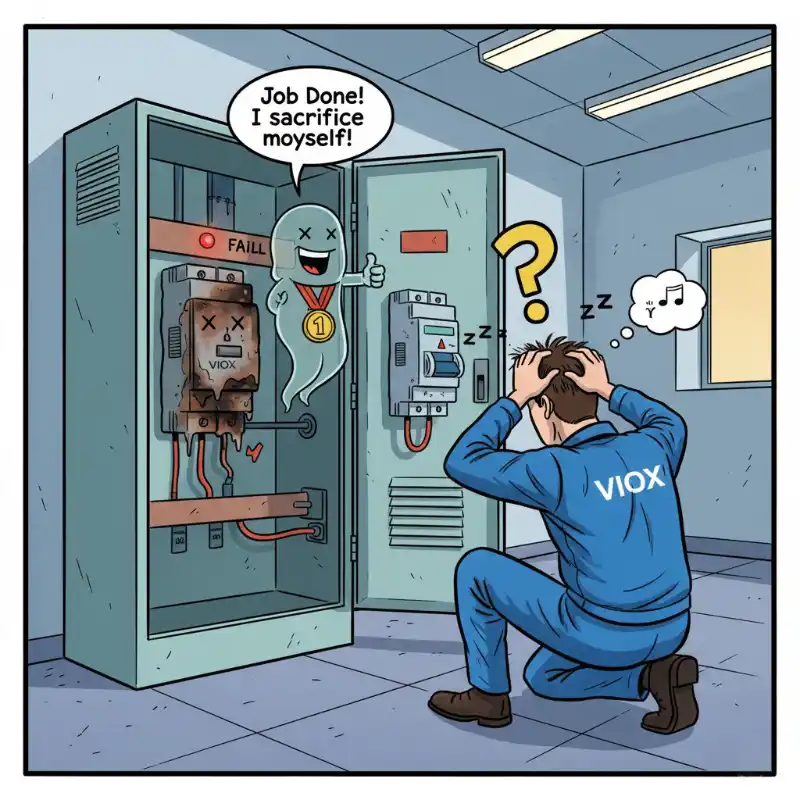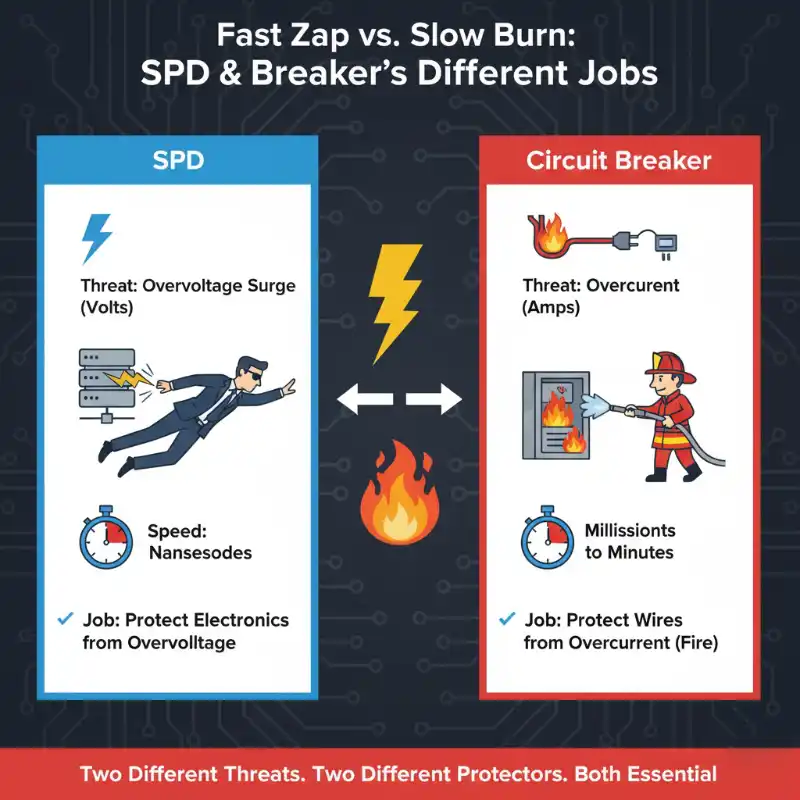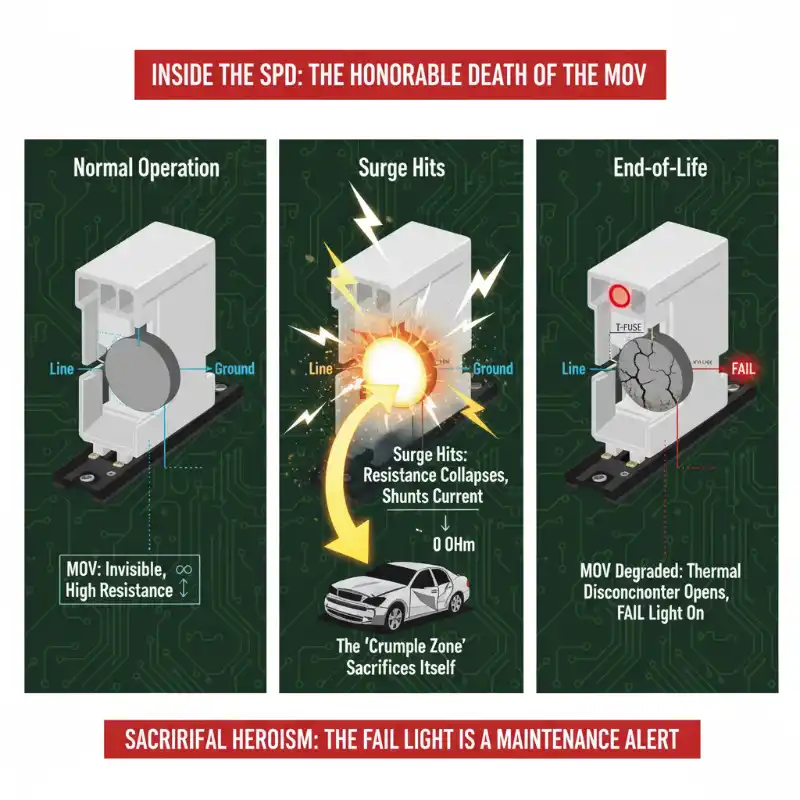You see it. The dreaded red “FAIL” light on your Túlfeszültségvédő eszköz (SPD).
Your technician’s mind kicks in. You go to the panel and check the upstream áramköri megszakító that feeds the SPD—a 32A breaker, just like the manufacturer specified.
It’s fine. It never tripped.
And that’s when the confusion starts. The logic doesn’t add up.
“Why didn’t the 32A breaker protect my SPD? What’s the point of the breaker if the SPD just dies? Did the SPD fail? Did the megszakító fail? Should I have used a bigger breaker?”
This is a fantastic question. It’s logical, it’s insightful, and it reveals one of the most common (and critical) misconceptions in electrical safety.
So, let me start with the short answer.
First: Congratulations. Your electrical protection system worked perfectly.
That “FAIL” light isn’t a sign of a bad product. It’s a medal of honor. You’ve just stumbled upon what I call “The Protection Paradox”—and understanding it is the key to a safe and reliable system.
Let’s tear this down, engineer to engineer.
1. The “Fast Zap” vs. “The Slow Burn”: Why Your Breaker Was Blind
The core of the paradox is this: Your breaker and your SPD are two completely different security systems, for two completely different threats.
They aren’t colleagues. They don’t even speak the same language.
- Your Circuit Breaker (OCPD) Fights “The Slow Burn” (Overcurrent)
- Its Job: To protect your wires from fire.
- Its Enemy: Túláram (Amps). This is a relatively slow event caused by overloads (too many heaters) or short circuits. It generates immense heat over time.
- Its Speed: Slow. A thermal-magnetic breaker reacts in milliseconds (for shorts) to many minutes (for small overloads).
- Your SPD Fights “The Fast Zap” (Overvoltage)
- Its Job: To protect your expensive electronics from being fried.
- Its Enemy: Overvoltage (Volts). This is a transient surge, a massive voltage spike from a lightning strike or grid fluctuation.
- Its Speed: Unbelievably fast. A VIOX SPD reacts in nanoseconds (billionths of a second).
Here’s the first “Aha!” moment: Your breaker is a fireman. Your SPD is a Secret Service agent.
The fireman is trained to stop a “slow burn” from engulfing the building. The agent is trained to dive in front of a “fast zap” (a bullet) to protect the VIP (your appliances).
You wouldn’t ask the fireman why he didn’t catch a bullet. He’s not built for it. In fact, by the time he even realizes a shot was fired, the agent has already done his job.
Pro-Tip #1: Your circuit breaker is physically blind to a voltage surge. The “fast zap” is over and gone millions of times faster than the breaker’s magnetic trip coil can even begin to move. It never saw the surge. It wasn’t supposed to.
2. Inside the SPD: The Honorable Death of the MOV
So, if the breaker didn’t do anything, what did happen? What does “FAIL” actually mean?
It means the Secret Service agent did his job. He took the bullet.
Inside nearly every SPD is the sacrificial hero of this story: the MOV (Metal Oxide Varistor).
You can think of an MOV as the “crumple zone” in your car. It’s a consumable component that is designed to destroy itself to save you.
- In Normal Times: The MOV sits on the line and “pretends” to be invisible. Its resistance is massive, so no current flows through it.
- When the Surge Hits: The instant the voltage spikes (the “fast zap”), the MOV’s resistance collapses to almost zero. It becomes a super-highway.
- The Sacrificial Act: In those nanoseconds, the MOV shunts (diverts) the entire surge, thousands of amps, safely away from your appliances and down to the ground.
This act of heroism takes a toll. Every surge it shunts, big or small, causes a tiny bit of “damage” to the MOV. After absorbing one massive surge, or hundreds of small ones over the years, the “crumple zone” is spent. It can’t take another hit.
This is what I call “The Honorable Death of the MOV.”
Pro-Tip #2: The “FAIL” light is not a sign of a defective product. It is a maintenance request. It’s the SPD’s way of telling you, “My internal ‘crumple zone’ is used up. I’ve done my job, and now I need to be replaced so I can protect you again.”
3. So What Actually Happened? The Full Timeline of Your “Failure”
Now we can reconstruct the true story of what happened in your panel. This is what separates a basic system from a truly safe, modern one.
What you saw—the FAIL light on, the breaker untouched—is the cleanest, safest way an SPD can end its life.
Here is the precise, step-by-step timeline:
Step 1: The Surge (Years Ago… or Yesterday).
A “fast zap” hits your building. Your SPD’s MOV leaps into action and shunts it to ground. Your computers and VFDs don’t even flicker. This may have been the MOV’s 100th small hit or 1st fatal one.
Step 2: The EOL (End-of-Life).
The MOV is now “spent.” It begins to degrade. As it does, a small amount of “leakage” current starts to trickle through it, which creates heat.
Step 3: The Belső Disconnection.
This is the crucial part. Modern, well-designed SPDs (like VIOX’s) have a built-in thermal disconnector. This is a tiny, precision fuse that only monitors the MOV. It saw that leakage current’s heat, recognized it as the beginning of the MOV’s end-of-life, and melted, safely disconnecting the dead MOV from the circuit.
Step 4: The “FAIL” Light.
This internal disconnection is wired to the indicator circuit. The moment that thermal disconnector opened, the “FAIL” light turned on.
The 32A breaker? It was never part of this story. It just sat there, happily feeding power to the rest of the circuit (and the now-disconnected SPD). The entire end-of-life event was handled perfectly inside the SPD itself.
4. The Fireman’s Duty: The 32A Breaker’s Real Job
This brings us back to your 32A breaker. If it didn’t do this job, what is it a oldalon.?
This is the most important takeaway for your safety.
The 32A breaker’s job is not to protect the SPD from a surge. The 32A breaker’s job is to protect your house from the SPD, in case the SPD fails in a catastrophic way.
This is what I call “The Fireman’s Duty.”
Let’s replay the timeline with a different, more violent ending.
- 1. lépés: A massive surge, far beyond the SPD’s rating, hits the line.
- 2. lépés: The MOV attempts to shunt it but is completely overwhelmed. It doesn’t just “degrade”—it explodes internally into a permanent, hard short circuit. It “fails-short.”
- 3. lépés: The MOV has now become a “traitor,” a 0-ohm bridge between your hot line and ground.
- Step 4: The Breaker’s Moment. Now, the “slow burn” begins. This short circuit draws a massive overcurrent, 500A… 1000A… 5000A…
- 5. lépés: The 32A breaker (the fireman) sees this violent “slow burn,” recognizes it as a dead short, and instantly trips in milliseconds—cutting power to the dead, shorted SPD before it can overheat, melt, and start a fire.
Pro-Tip #3: That 32A breaker is the SPD’s Overcurrent Protective Device (OCPD). Its job is to perform “The Fireman’s Duty” and prevent the SPD’s corpse from starting a fire. This is why the SPD manufacturer előírja it.
5. WARNING: Why Your “Fix” Is a Dangerous Fire Hazard
Now we can see why your initial thought, “Maybe I should use a stronger breaker,” is so incredibly dangerous.
Let’s run that simulation.
You ignore the 32A recommendation and install a “stronger” 40A breaker, or maybe a D-curve breaker that’s slower to trip.
- The SPD’s MOV fails-short.
- The dead MOV creates a short circuit that pulls, say, 38 Amps.
- A new 40A breaker looks at this and says, “38 Amps? No problem. That’s below my rating. I’ll just sit here.”
- But the SPD’s internal wiring and components were only designed to be protected by a 32A OCPD.
- That “extra” 6A of current (or more) now has nowhere to go. The 38A flows continuously through the dead MOV, which acts like a toaster element. It glows red hot. The plastic casing of the SPD melts, smokes, and then ignites.
- The 40A breaker still hasn’t tripped, because the fire you just started is still only pulling 38A.
You just bypassed the one safety system designed to prevent the SPD from starting a fire.
Pro-Tip #4: ALWAYS use the exact OCPD (breaker or fuse) rating specified by your SPD manufacturer. Never “upsize” it for bármilyen reason. The manufacturer (like VIOX) has tested this coordination to ensure the breaker will trip mielőtt the SPD’s internal wiring melts.
Your System Worked. That “FAIL” Light is a Trophy.
So, let’s go back to your panel.
That “FAIL” light isn’t a sign of failure. It’s a trophy. It’s a medal of honor that your SPD is wearing to tell you it died in the line of duty, protecting your far more expensive equipment.
Your 32A breaker is doing its job: standing guard, ready for “The Fireman’s Duty” just in case. And your SPD did its job: it handled its own “Honorable Death” cleanly and quietly, and is now simply telling you it’s time to swap in a new soldier.
Your system is perfect. The “FAIL” light is just a maintenance alert.
Time to thank that SPD for its service and get a new one on the line.
Technical Accuracy Note
Standards & Sources Referenced: This article is based on the coordination principles outlined in IEC 61643-12 (for low-voltage SPDs) and UL 1449.
Timeliness Statement: All protection principles and end-of-life behaviors are accurate for modern SPDs (Type 1, 2, and 3) as of November 2025.
Felelősségi nyilatkozat: Always follow your specific SPD manufacturer’s installation manual, including all OCPD requirements.








